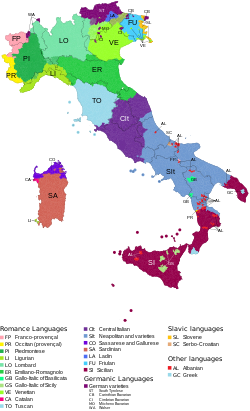Demographics of Italy
Italian government data, in its annual report for 2019, estimated the number of foreign nationals residing within Italy, including immigrants, at about 5.234 million.High fertility and birth rates persisted until the 1970s, after which they started to dramatically decline, leading to rapid population aging.[7] Since the revision of the Lateran Treaty in 1984, Italy has no official religion, although it continues to recognize the role the Catholic Church plays in Italian society.[45] The reasons that Italians give for not having children are economic costs, fear of losing their job and lack of services for families, but it is claimed that these problems have ceased to be the main motivation for childlessness.[dubious – discuss][45] Other countries such as Sweden and France with superior childcare service and better job conditions also have birth rates below the population replacement level, which is approximately 2.1.[66] [62] Total fertility rate (TFR) in Italy by region as of 2023: Obesity – adult prevalence rate Unemployment, youth ages 15–24: Since the fall of the Berlin Wall in 1989, and more recently, the 2004 and 2007 enlargements of the European Union, Italy received growing flows of migrants from the former socialist countries of Eastern Europe (especially Romania, Albania, Ukraine and Poland).[69] Furthermore, in recent years, growing migration fluxes from the Far East (notably, China[70] and the Philippines) and Latin America (Ecuador, Peru) have been recorded.[33] These figures do not include naturalized foreign-born residents (121,457 foreigners acquired Italian citizenship in 2021)[72] as well as illegal immigrants, the so-called clandestini, whose numbers, difficult to determine, are thought to be at least 670,000.French is co-official in the Aosta Valley as the province's prestige variety, under which the more commonly spoken Franco-Provencal dialects have been historically roofed.UNESCO and other authorities recognize a number of other languages which are not legally protected by Italian government: Piedmontese, Venetian, Ligurian, Lombard, Emilian-Romagnolo, Neapolitan and Sicilian.Even though by law Vatican City is not part of Italy, it is in Rome, and along with Latin, Italian is the most spoken and second language of the Roman Curia.Roman Catholic art in Italy especially flourished during the Middle Ages, Renaissance and Baroque periods, with numerous Italian artists, such as Michelangelo, Leonardo da Vinci, Raphael, Caravaggio, Fra Angelico, Gian Lorenzo Bernini, Sandro Botticelli, Tintoretto, Titian and Giotto.Italy has seen many influential Italian-Jews, such as prime minister Luigi Luzzatti, who took office in 1910, Ernesto Nathan served as mayor of Rome from 1907 to 1913 and Shabbethai Donnolo (died 982).The ancestors of Italians are mostly Indo-European speakers (Italic peoples such as Latins, Umbrians, Samnites, Oscans, Sicels and Adriatic Veneti, as well as Celts, Iapygians and Greeks) and pre-Indo-European speakers (Etruscans, Ligures, Rhaetians and Camunni in mainland Italy, Sicani and Elymians in Sicily and the Nuragic people in Sardinia).[127] Based on DNA analysis, there is evidence of ancient regional genetic substructure and continuity within modern Italy dating to the pre-Roman and Roman periods.[132] In this regard, peoples like the Friulians, the Ladins, the Sardinians and the South Tyroleans, who also happen to constitute recognized linguistic minorities, or even the Sicilians who are not, are cases in point, attesting to such internal diversity.Linguistic minorities in Italy include Sardu-speakers 1 million, Tyrolese German-speakers 350,000, Albanians 70,000 – 100,000, Slovenes 60,000, Franco-Provençal-speakers 50,000 – 70,000, Occitans 20,000 – 40,000, Ladins 30,000, Catalans 15,000, Greek-speakers 12,000, Croatians 3,000 and Friulians 600,000.
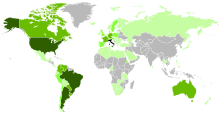
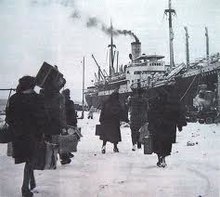
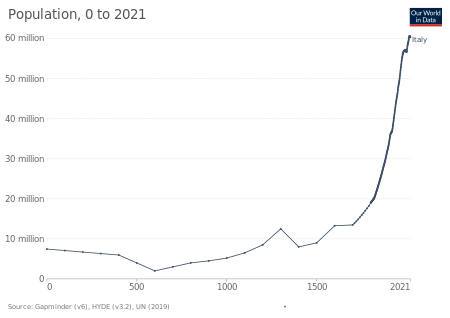
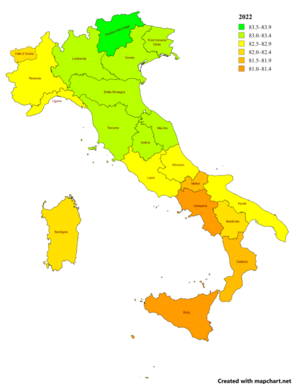
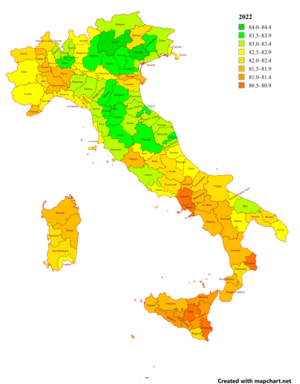
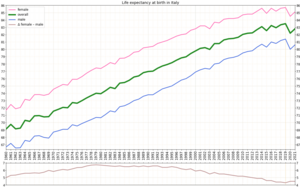
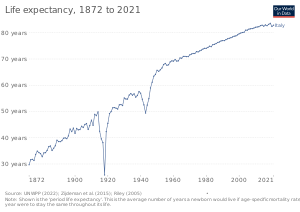
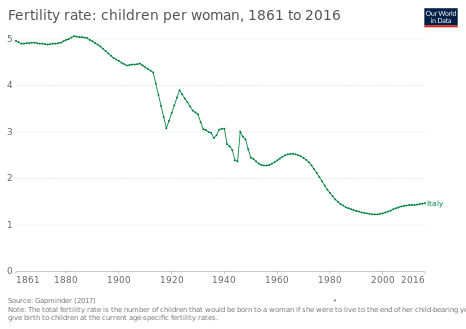
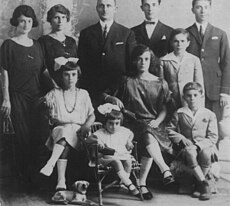

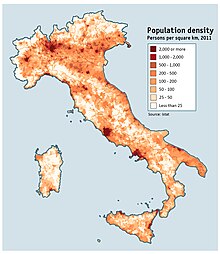
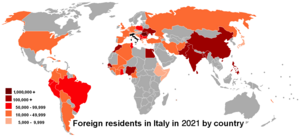

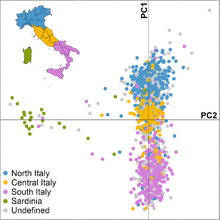
ItaliansSiciliansSardiniansRomaniansAfro-ItaliansAlbaniansUkrainiansItalianLanguages of ItalyDemographicpopulation densityethnicityreligious affiliationsPo Valleynorthern ItalyNaplescentralsouthern ItalyBasilicataApenninesSardiniainternal migration from the rural South to the industrial cities of the NorthItalian economic miracleimmigrationLateran TreatyCatholic ChurchItalian diasporaits unificationItalian BraziliansItalian ArgentinesItalian AmericansItalian FrenchItalian VenezuelansItalian ParaguayansItalian ColombiansItalian UruguayansItalian PeruviansItalian CanadiansItalian GermansItalian AustralianscoloniesEritreaSomaliaItalians settled in LibyaIstrian ItaliansIstrian-Dalmatian exodusIstriaKvarnerJulian MarchDalmatianTreaty of Peace with Italy, 1947Dalmatian Italianscommunist YugoslaviaIstrian–Dalmatian exodusMuammar Gaddafi's takeoverEurozone crisisdouble-dip recessionCOVID-19 pandemiclife expectancyWorld War ISpanish flu pandemicList of Italian provinces by life expectancyOur World In DatabirthsGDP growthsocial securityservicesfamilieschildlessnessSwedenFrancechildcarebirth rates below the population replacement leveltotal fertility rateGapminder Foundationnuclear familyInternal migration in ItalyFalck steelworksSesto San GiovanniLombardyhuman migrationItalian geographical regionemigrationSicilyNorman conquest of southern ItalyRoger I of SicilyAdelaide del VastoAleramiciPiedmontLiguriaMetropolitan areas in ItalyList of cities in Italy by populationdevolutionmetropolitan areaprovincialMetropolitan cityRegionCampaniaPalermoApuliaCataniaFlorenceTuscanyBolognaEmilia-RomagnaVeniceVenetoMessinaReggio CalabriaCalabriaCagliariTotal fertility ratesTrentino-Alto AdigeFriuli-Venezia GiuliaMarcheAosta ValleyAbruzzoUmbriaMoliseImmigration to ItalyRomaniaAlbaniaUkrainePolandMoroccoTunisia
